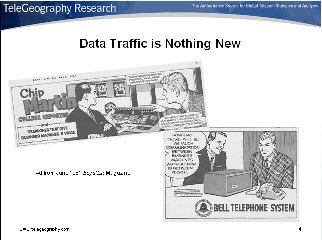History
- 1961 Vision from AT&T (courtesy of Telegeography) computers will talk to one another, at the time via data modems.
Chip: "You mean two business machines thousands of miles apart can actually talk to each other by telephone".
Company person: "Some day there will be as much communication between business machines as there now is between people".
- 1965: Larry Roberts and Thomas Marill create the first wide area connection via telephone line, turns out to be inefficient and costly. Kelinrock predicts that packet switching (developed by Baran, Davies, Kleinrock et. al. is more promising)
- 1969 Then in 1983, the original Internet created and had 4 nodes, UCLA, Stanford Research Institute, MIT, Utah, 50kbit backbone (today a modem nb scaling up a million times) Jan 83 400 nodes, now 750M
- Built as a collaboration of global proportions, independent stand on own, self managed autonomous systems (Bill Cheswick autonomous map 1999) , decentralized (chaotic, no central control/management cf phone system), best effort, no guarantees, recovery from losses, pipelining (TCP), host flow control, checksums, non-proprietary (c.f. SNA, DECnet, XNS …), little focus on security (if had focused on this might never have happened), simple black boxes (routers connect nets) that do not retain information about the individual flows, packets inside envelopes, layering (independent of each other, i.e. middle layers don’t know if lower layers are wireless, satellite, copper, fibre, upper layer independent of applications cf purpose designed TV broadcast networks, cable networks, telephone network, only end device knows what the contents mean).
...
